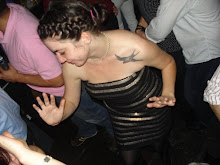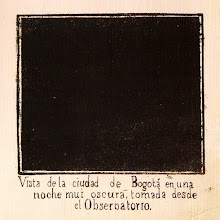The Cementerio Cenral is by the 26, a huge road that stretches through the city past the Universidad Nacional to the airport. In the past it was the place to be for deceased Bogotanos, but these days it's fallen into disrepair and the affluent bury their relatives in grassy graveyards outside the city. The cemetery opened its doors in 1832 and houses some of the biggest names of Colombian politics including Luis Carlos Galan, Carlos Pizarro (both assassinated) and a whole slew of presidents. Also present are entrepreneurs and members of Bogota's ruling families, mingling with 19th-century bourgeois and modern-day working class city residents.
At the entrance a guard with an unnerving shotgun waves you through the high gates with a stony Father Time perched on top. Inside there is a central area which contains presidents and suchhlike, and an outer part with slightly less eminent members of Bogota society, fading into and area of normal people packed into walls of small boxes with names and crucifixes in endless rows. Narrow avenues of crumbling mausoleums draw you deeper into the cemetery, while the roar of incessant traffic on the 26 fades to a murmur.
This outer part of the cemetery is still in use, and generations of families end their days in these little boxes festooned with gaudy flowers carefully arranged in cut-off Coca Cola bottles filled with greenish water. You may bear witness to a funeral in process, often of young men killed in gang violence. While the mother wails over the coffin and begs for things to be different, the grim-faced cousins and friends slowly transport their friend towards his final destination while a somber group of mariachis trumpet a last serenade. On the fringes of the funeral party two men with shifty eyes adjust the revolvers that are stuffed into the waistband of their trousers.
Further away from the raw reality of 21st-century death is the central section of the cemetery, a walled oval filled with ornate mausoleums and presidential memorials. An impressive central avenue takes you past a number of businessmen, political figures and cultural leaders of the past two centuries. Galan's incongruous Modernist monument resides amongst the faux-Baroque tombstones and saccharine statues of angels and virgins, made even more poignant by its simplicity and clean lines.
To the right hand side of the avenue sits one of the most interesting monuments of the cemetery. A shining golden statue laden with brash flowers gleams amongst the cracked concrete paths and dusty overhanging trees. This is the tomb of Don Leo Kopp, a Geman immigrant who founded the Bavaria brewery. Don Leo and his company were responsible for the construction of the La Perseverancia, originally a neighborhood for the workers at Bavaria. Gaitan was born in La Perseverancia, and there is a statue honoring him in this still staunchly working-class area of the city. Don Leo was famed for his decency and for helping his workers to construct their own houses. Upon his death a strong cult developed around his monument, and every day people come to ask favors of the city's most beloved Jewish Mason. Two transvestites resplendent in eye-poppingly short Lycra dresses show off the kind of curves that only silicone can achieve, while they tenderly whisper their heart's desires in the ear of Don Leo, caressing his wavy gilt hair. The statue's shine is maintained by its devotees, who visit mainly on Mondays to repay their helper by way of a little spit and polish and some pink chrysanthemums.
The Cementerio Central is little-known among Bogotanos and as result of this is in a lamentable state of disrepair. However, a visit to this most fascinating of monuments to Colombia's tumultuous history is most definitely worthwhile. During the week the cemetery can be very empty, so the best days to visit are Saturday, Sunday or Monday as these are the days with most visitors.














 The place was also filled with equally out-of-place soliders with big guns, you´d just be sitting there getting tucked into a plate of the local speciality (trout with patacón, a big crispy pancake made out of platano and deepfried, needless to say we had this delectable dish for four days on the trot) and suddenly everything´s gone a bit military. Everything was very calm though, for the most part the soldiers seemed to be enjoying the crap lounge music being sung to guests of a swank restaurant (not the one we were eating in, needless to say) by an unspeakably suave chap in a white suit, or cracking on to nice local girls. Perhaps the best thing about this day was catching a Jeep (traditional mode of transport in the Eje Cafetero, there´s even a town somewhere (whose name escapes me) where every year they have a big procession of Jeeps all loaded up with sacks of coffee and flowers and proudly drive them through the streets) back to Salento and me and Mark getting to ride on TOP of that bad boy! The road was amazing as well, quite a lot of it was in very good nick and you just flew along beside this windy river among rolling green mountains and little farms painted red and green with flowers all over the verandas, wee boys on bikes sailing along beside excited dogs and overhanging trees that you had to watch out for and duck at the appropriate moment. Life in Colombia means a life of extremely interesting public transport. During the course of this holiday i travelled on Jeeps, buses (tiny and enormous), chiva (a big van with benches that fit 6 people, all painted brightly coloured and with no glass in the windows, just coffee sacks you could roll down if it rained, and the driver had two Virgin Marys positioned on either side of the rear view mirror, noe that lit up when he accelerated and one that lit up when he braked. Those Virgins were going like strobe lights as the guy sped along the alarmingly windy road, braking every 2 minutes to let more people on, to avoid motorbikes, simply to admire the view at some points...), cable cars, busetas, taxis, everything!
The place was also filled with equally out-of-place soliders with big guns, you´d just be sitting there getting tucked into a plate of the local speciality (trout with patacón, a big crispy pancake made out of platano and deepfried, needless to say we had this delectable dish for four days on the trot) and suddenly everything´s gone a bit military. Everything was very calm though, for the most part the soldiers seemed to be enjoying the crap lounge music being sung to guests of a swank restaurant (not the one we were eating in, needless to say) by an unspeakably suave chap in a white suit, or cracking on to nice local girls. Perhaps the best thing about this day was catching a Jeep (traditional mode of transport in the Eje Cafetero, there´s even a town somewhere (whose name escapes me) where every year they have a big procession of Jeeps all loaded up with sacks of coffee and flowers and proudly drive them through the streets) back to Salento and me and Mark getting to ride on TOP of that bad boy! The road was amazing as well, quite a lot of it was in very good nick and you just flew along beside this windy river among rolling green mountains and little farms painted red and green with flowers all over the verandas, wee boys on bikes sailing along beside excited dogs and overhanging trees that you had to watch out for and duck at the appropriate moment. Life in Colombia means a life of extremely interesting public transport. During the course of this holiday i travelled on Jeeps, buses (tiny and enormous), chiva (a big van with benches that fit 6 people, all painted brightly coloured and with no glass in the windows, just coffee sacks you could roll down if it rained, and the driver had two Virgin Marys positioned on either side of the rear view mirror, noe that lit up when he accelerated and one that lit up when he braked. Those Virgins were going like strobe lights as the guy sped along the alarmingly windy road, braking every 2 minutes to let more people on, to avoid motorbikes, simply to admire the view at some points...), cable cars, busetas, taxis, everything!




